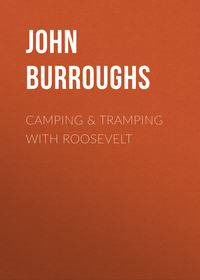 полная версия
полная версияWake-Robin
The Adirondac Iron Works belong to the past. Over thirty years ago a company in Jersey City purchased some sixty thousand acres of land lying along the Adirondac River and abounding in magnetic iron ore. The land was cleared, roads, dams, and forges constructed, and the work of manufacturing iron begun.
At this point a dam was built across the Hudson, the waters of which flowed back into Lake Sandford, about five miles above. The lake itself being some six miles long, tolerable navigation was thus established for a distance of eleven miles, to the Upper Works, which seem to have been the only works in operation. At the Lower Works, besides the remains of the dam, the only vestige I saw was a long low mound, overgrown with grass and weeds, that suggested a rude earth-work. We were told that it was once a pile of wood containing hundreds of cords, cut in regular lengths and corded up here for use in the furnaces.
At the Upper Works, some twelve miles distant, quite a village had been built, which was now entirely abandoned, with the exception of a single family.
A march to this place was our next undertaking. The road for two or three miles kept up from the river and led us by three or four rough, stumpy farms. It then approached the lake and kept along its shores. It was here a dilapidated corduroy structure that compelled the traveler to keep an eye on his feet. Blue jays, two or three small hawks, a solitary wild pigeon, and ruffed grouse were seen along the route. Now and then the lake gleamed through the trees, or we crossed on a shaky bridge some of its arms or inlets. After a while we began to pass dilapidated houses by the roadside. One little frame house I remember particularly; the door was off the hinges and leaned against the jambs, the windows had but a few panes left which glared vacantly. The yard and little garden spot were overrun with a heavy growth of timothy, and the fences had all long since gone to decay. At the head of the lake a large stone building projected from the steep bank and extended over the road. A little beyond the valley opened to the east, and looking ahead about one mile we saw smoke going up from a single chimney. Pressing on, just as the sun was setting we entered the deserted village. The barking of the dog brought the whole family into the street, and they stood till we came up. Strangers in that country were a novelty, and we were greeted like familiar acquaintances.
Hunter, the head, proved to be a first-rate type of an Americanized Irishman. His wife was a Scotch woman. They had a family of five or six children, two of them grown-up daughters – modest, comely young women as you would find anywhere. The elder of the two had spent a winter in New York with her aunt, which perhaps made her a little more self-conscious when in the presence of the strange young men. Hunter was hired by the company at a dollar a day to live here and see that things were not wantonly destroyed but allowed to go to decay properly and decently. He had a substantial roomy frame house and any amount of grass and woodland. He had good barns and kept considerable stock, and raised various farm products, but only for his own use, as the difficulties of transportation to market some seventy miles distant made it no object. He usually went to Ticonderoga on Lake Champlain once a year for his groceries, etc. His post-office was twelve miles below at the Lower Works, where the mail passed twice a week. There was not a doctor, or lawyer, or preacher within twenty-five miles. In winter, months elapse without their seeing anybody from the outside world. In summer, parties occasionally pass through here on their way to Indian Pass and Mount Marcy. Hundreds of tons of good timothy hay annually rot down upon the cleared land.
After nightfall we went out and walked up and down the grass-grown streets. It was a curious and melancholy spectacle. The remoteness and surrounding wildness rendered the scene doubly impressive. And the next day and the next the place was an object of wonder. There were about thirty buildings in all, most of them small frame houses with a door and two windows opening into a small yard in front and a garden in the rear, such as are usually occupied by the laborers in a country manufacturing district. There was one large two-story boarding-house, a school-house with a cupola and a bell in it, and numerous sheds and forges, and a saw-mill. In front of the saw-mill, and ready to be rolled to their place on the carriage, lay a large pile of pine logs, so decayed that one could run his walking-stick through them. Near by, a building filled with charcoal was bursting open and the coal going to waste on the ground. The smelting works were also much crumbled by time. The school-house was still used. Every day one of the daughters assembles her smaller brothers and sisters there and school keeps. The district library contained nearly one hundred readable books, which were well thumbed.
The absence of society, etc., had made the family all good readers. We brought them an illustrated newspaper which was awaiting them in the post-office at the Lower Works. It was read and reread with great eagerness by every member of the household.
The iron ore cropped out on every hand. There was apparently mountains of it; one could see it in the stones along the road. But the difficulties met with in separating the iron from its alloys, together with the expense of transportation and the failure of certain railroad schemes, caused the works to be abandoned. No doubt the time is not distant when these obstacles will be overcome and this region reopened.
At present it is an admirable place to go to. There is fishing and hunting and boating and mountain climbing within easy reach, and a good roof over your head at night, which is no small matter. One is often disqualified for enjoying the woods after he gets there by the loss of sleep and of proper food taken at seasonable times. This point attended to, and one is in the humor for any enterprise.
About half a mile northeast of the village is Lake Henderson, a very irregular and picturesque sheet of water, surrounded by dark evergreen forests, and abutted by two or three bold promontories with mottled white and gray rocks. Its greatest extent in any one direction is perhaps less than a mile. Its waters are perfectly clear and abound in lake trout. A considerable stream flows into it which comes down from Indian Pass.
A mile south of the village is Lake Sandford. This is a more open and exposed sheet of water and much larger. From some parts of it Mount Marcy and the gorge of the Indian Pass are seen to excellent advantage. The Indian Pass shows as a huge cleft in the mountain, the gray walls rising on one side perpendicularly for many hundred feet. This lake abounds in white and yellow perch and in pickerel; of the latter single specimens are often caught which weigh fifteen pounds. There were a few wild ducks on both lakes. A brood of the goosander or red merganser, the young not yet able to fly, were the occasion of some spirited rowing. But with two pairs of oars in a trim light skiff, it was impossible to come up with them. Yet we could not resist the temptation to give them a chase every day when we first came on the lake. It needed a good long pull to sober us down so we could fish.
The land on the east side of the lake had been burnt over, and was now mostly grown up with wild cherry and red raspberry-bushes. Ruffed grouse were found here in great numbers. The Canada grouse was also common. I shot eight of the latter in less than an hour on one occasion; the eighth one, which was an old male, was killed with smooth pebble stones, my shot having run short. The wounded bird ran under a pile of brush, like a frightened hen. Thrusting a forked stick down through the interstices I soon stopped his breathing. Wild pigeons were quite numerous also. These latter recall a singular freak of the sharp shinned hawk. A flock of pigeons alighted on the top of a dead hemlock standing in the edge of a swamp. I got over the fence and moved toward them across an open space. I had not taken many steps, when on looking up I saw the whole flock again in motion flying very rapidly around the butt of a hill. Just then this hawk alighted on the same tree. I stepped back into the road and paused a moment in doubt which course to go. At that instant the little hawk launched into the air and came as straight as an arrow toward me. I looked in amazement, but in less than half a minute he was within fifty feet of my face, coming full tilt as if he had sighted my nose. Almost in self-defense I let fly one barrel of my gun, and the mangled form of the audacious marauder fell literally between my feet.
Of wild animals, such as bears, panthers, wolves, wild cats, etc., we neither saw nor heard any in the Adirondacs. “A howling wilderness,” Thoreau says, “seldom ever howls. The howling is chiefly done by the imagination of the traveler.” Hunter said he often saw bear tracks in the snow, but had never yet met Bruin. Deer are more or less abundant everywhere, and one old sportsman declares there is yet a single moose in these mountains. On our return, a pioneer settler, at whose house we stayed over-night, told us a long adventure he had had with a panther. He related how it screamed, how it followed him in the brush, how he took to his boat, how its eyes gleamed from the shore, and how he fired his rifle at them with fatal effect. His wife in the mean time took something from a drawer, and as her husband finished his recital, she produced a toe-nail of the identical animal with marked dramatic effect.
But better than fish or game or grand scenery or any adventure by night or day, is the wordless intercourse with rude Nature one has on these expeditions. It is something to press the pulse of our old mother by mountain lakes and streams, and know what health and vigor are in her veins, and how regardless of observation she deports herself.
BIRDS’-NESTS
How alert and vigilant the birds are, even when absorbed in building their nests! In an open space in the woods I see a pair of cedar-birds collecting moss from the top of a dead tree. Following the direction in which they fly, I soon discover the nest placed in the fork of a small soft-maple, which stands amid a thick growth of wild cherry-trees and young beeches. Carefully concealing myself beneath it without any fear that the workmen will hit me with a chip or let fall a tool, I await the return of the busy pair. Presently I hear the well-known note, and the female sweeps down and settles unsuspectingly into the half-finished structure. Hardly have her wings rested before her eye has penetrated my screen, and with a hurried movement of alarm she darts away. In a moment the male, with a tuft of wool in his beak (for there is a sheep-pasture near), joins her, and the two reconnoitre the premises from the surrounding bushes. With their beaks still loaded, they move around with a frightened look, and refuse to approach the nest till I have moved off and lain down behind a log. Then one of them ventures to alight upon the nest, but, still suspecting all is not right, quickly darts away again. Then they both together come, and after much peeping and spying about, and apparently much anxious consultation, cautiously proceed to work. In less than half an hour it would seem that wool enough has been brought to supply the whole family, real and prospective, with socks, if needles and fingers could be found fine enough to knit it up. In less than a week the female has begun to deposit her eggs, – four of them in as many days, – white tinged with purple, with black spots on the larger end. After two weeks of incubation, the young are out.
Excepting the American goldfinch, this bird builds later in the spring than any other – its nest, in our northern climate, seldom being undertaken till July. As with the goldfinch, the reason is, probably, that suitable food for the young cannot be had at an earlier period.
Like most of our common species, as the robin, sparrow, bluebird, pewee, wren, etc., this bird sometimes seeks wild, remote localities in which to rear its young; at others, takes up its abode near that of man. I knew a pair of cedar-birds, one season, to build in an apple-tree, the branches of which rubbed against the house. For a day or two before the first straw was laid, I noticed the pair carefully exploring every branch of the tree, the female taking the lead, the male following her with an anxious note and look. It was evident that the wife was to have her choice this time; and, like one who thoroughly knew her mind, she was proceeding to take it. Finally the site was chosen upon a high branch, extending over one low wing of the house. Mutual congratulations and caresses followed, when both birds flew away in quest of building material. That most freely used is a sort of cotton-bearing plant, which grows in old worn-out fields. The nest is large for the size of the bird, and very soft. It is in every respect a first-class domicile.
On another occasion, while walking or rather sauntering in the woods (for I have discovered that one cannot run and read the book of nature), my attention was arrested by a dull hammering, evidently but a few rods off. I said to myself, “Some one is building a house.” From what I had previously seen, I suspected the builder to be a red-headed woodpecker in the top of a dead oak stub near by. Moving cautiously in that direction, I perceived a round hole, about the size of that made by an inch and a half auger, near the top of the decayed trunk, and the white chips of the workman strewing the ground beneath. When but a few paces from the tree, my foot pressed upon a dry twig, which gave forth a very slight snap. Instantly the hammering ceased, and a scarlet head appeared at the door. Though I remained perfectly motionless, forbearing even to wink till my eyes smarted, the bird refused to go on with his work, but flew quietly off to a neighboring tree. What surprised me was, that amid his busy occupation down in the heart of the old tree, he should have been so alert and watchful as to catch the slightest sound from without.
The woodpeckers all build in about the same manner, excavating the trunk or branch of a decayed tree and depositing the eggs on the fine fragments of wood at the bottom of the cavity. Though the nest is not especially an artistic work, – requiring strength rather than skill, – yet the eggs and the young of few other birds are so completely housed from the elements, or protected from their natural enemies – the jays, crows, hawks, and owls. A tree with a natural cavity is never selected, but one which has been dead just long enough to have become soft and brittle throughout. The bird goes in horizontally for a few inches, making a hole perfectly round and smooth and adapted to his size, then turns downward, gradually enlarging the hole, as he proceeds, to the depth of ten, fifteen, twenty inches, according to the softness of the tree and the urgency of the mother-bird to deposit her eggs. While excavating, male and female work alternately. After one has been engaged fifteen or twenty minutes, drilling and carrying out chips, it ascends to an upper limb, utters a loud call or two, when its mate soon appears, and, alighting near it on the branch, the pair chatter and caress a moment, then the fresh one enters the cavity and the other flies away.
A few days since I climbed up to the nest of the downy woodpecker, in the decayed top of a sugar-maple. For better protection against driving rains, the hole, which was rather more than an inch in diameter, was made immediately beneath a branch which stretched out almost horizontally from the main stem. It appeared merely a deeper shadow upon the dark and mottled surface of the bark with which the branches were covered, and could not be detected by the eye until one was within a few feet of it. The young chirped vociferously as I approached the nest, thinking it was the old one with food; but the clamor suddenly ceased as I put my hand on that part of the trunk in which they were concealed, the unusual jarring and rustling alarming them into silence. The cavity, which was about fifteen inches deep, was gourd-shaped, and was wrought out with great skill and regularity. The walls were quite smooth and clean and new.
I shall never forget the circumstance of observing a pair of yellow-bellied woodpeckers – the most rare and secluded, and, next to the red-headed, the most beautiful species found in our woods, – breeding in an old, truncated beech in the Beaverkill Mountains, an offshoot of the Catskills. We had been traveling, three of us, all day in search of a trout lake, which lay far in among the mountains, had twice lost our course in the trackless forest, and, weary and hungry, had sat down to rest upon a decayed log. The chattering of the young, and the passing to and fro of the parent birds, soon arrested my attention. The entrance to the nest was on the east side of the tree, about twenty-five feet from the ground. At intervals of scarcely a minute, the old birds, one after another, would alight upon the edge of the hole with a grub or worm in their beaks; then each in turn would make a bow or two, cast an eye quickly around, and by a single movement place itself in the neck of the passage. Here it would pause a moment, as if to determine in which expectant mouth to place the morsel, and then disappear within. In about half a minute, during which time the chattering of the young gradually subsided, the bird would again emerge, but this time bearing in its beak the ordure of one of the helpless family. Flying away very slowly with head lowered and extended, as if anxious to hold the offensive object as far from its plumage as possible, the bird dropped the unsavory morsel in the course of a few yards, and alighting on a tree, wiped its bill on the bark and moss. This seems to be the order all day, – carrying in and carrying out. I watched the birds for an hour, while my companions were taking their turn in exploring the lay of the land around us, and noted no variation in the programme. It would be curious to know if the young are fed and waited upon in regular order, and how, amid the darkness and the crowded state of the apartment, the matter is so neatly managed. But ornithologists are all silent upon the subject.
This practice of the birds is not so uncommon as it might at first seem. It is indeed almost an invariable rule among all land-birds. With woodpeckers and kindred species, and with birds that burrow in the ground, as bank swallows, kingfishers, etc., it is a necessity. The accumulation of the excrement in the nest would prove most fatal to the young.
But even among birds that neither bore nor mine, but which build a shallow nest on the branch of a tree or upon the ground, as the robin, the finches, the buntings, etc., the ordure of the young is removed to a distance by the parent bird. When the robin is seen going away from its brood with a slow heavy flight, entirely different from its manner a moment before on approaching the nest with a cherry or worm, it is certain to be engaged in this office. One may observe the social-sparrow, when feeding its young, pause a moment after the worm has been given and hop around on the brink of the nest observing the movements within.
The instinct of cleanliness no doubt prompts the action in all cases, though the disposition to secrecy or concealment may not be unmixed with it.
The swallows form an exception to the rule, the excrement being voided by the young over the brink of the nest. They form an exception, also, to the rule of secrecy, aiming not so much to conceal the nest as to render it inaccessible.
Other exceptions are the pigeons, hawks, and water-fowls.
But to return. Having a good chance to note the color and markings of the woodpeckers as they passed in and out at the opening of the nest, I saw that Audubon had made a mistake in figuring or describing the female of this species with the red spot upon the head. I have seen a number of pairs of them, and in no instance have I seen the mother-bird marked with red.
The male was in full plumage, and I reluctantly shot him for a specimen. Passing by the place again next day I paused a moment to note how matters stood. I confess it was not without some compunctions that I heard the cries of the young birds, and saw the widowed mother, her cares now doubled, hastening to and fro in the solitary woods. She would occasionally pause expectantly on the trunk of a tree, and utter a loud call.
It usually happens when the male of any species is killed during the breeding season, that the female soon procures another mate. There are, most likely, always a few unmated birds of both sexes, within a given range, and through these the broken links may be restored. Audubon or Wilson, I forget which, tells of a pair of fish-hawks, or ospreys, that built their nest in an ancient oak. The male was so zealous in the defense of the young that it actually attacked with beak and claw a person who attempted to climb into his nest, putting his face and eyes in great jeopardy. Arming himself with a heavy club, the climber felled the gallant bird to the ground and killed him. In the course of a few days the female had procured another mate. But naturally enough the step-father showed none of the spirit and pluck in defense of the brood that had been displayed by the original parent. When danger was nigh he was seen afar off, sailing around in placid unconcern.
It is generally known that when either the wild turkey or domestic turkey begins to lay, and afterwards to sit and rear the brood, she secludes herself from the male, who then, very sensibly, herds with others of his sex, and betakes himself to haunts of his own till male and female, old and young, meet again on common ground, late in the fall. But rob the sitting bird of her eggs, or destroy her tender young, and she immediately sets out in quest of a male, who is no laggard when he hears her call. The same is true of ducks and other aquatic fowls. The propagating instinct is strong, and surmounts all ordinary difficulties. No doubt the widowhood I had caused in the case of the woodpeckers was of short duration, and chance brought, or the widow drummed up, some forlorn male, who was not dismayed by the prospect of having a large family of half-grown birds on his hands at the outset.
I have seen a fine cock robin paying assiduous addresses to a female bird, as late as the middle of July; and I have no doubt that his intentions were honorable. I watched the pair for half an hour. The hen, I took it, was in the market for the second time that season; but the cock, from his bright, unfaded plumage, looked like a new arrival. The hen resented every advance of the male. In vain he strutted around her and displayed his fine feathers; every now and then she would make at him in a most spiteful manner. He followed her to the ground, poured into her ear a fine, half-suppressed warble, offered her a worm, flew back to the tree again with a great spread of plumage, hopped around her on the branches, chirruped, chattered, flew gallantly at an intruder, and was back in an instant at her side. No use, – she cut him short at every turn.
The dénouement I cannot relate, as the artful bird, followed by her ardent suitor, soon flew away beyond my sight. It may not be rash to conclude, however, that she held out no longer than was prudent.
On the whole, there seems to be a system of Women’s Rights prevailing among the birds, which, contemplated from the stand-point of the male, is quite admirable. In almost all cases of joint interest, the female bird is the most active. She determines the site of the nest, and is usually the most absorbed in its construction. Generally, she is more vigilant in caring for the young, and manifests the most concern when danger threatens. Hour after hour I have seen the mother of a brood of blue grossbeaks pass from the nearest meadow to the tree that held her nest, with a cricket or grasshopper in her bill, while her better-dressed half was singing serenely on a distant tree or pursuing his pleasure amid the brunches.
Yet among the majority of our song-birds the male is most conspicuous both by his color and manners and by his song, and is to that extent a shield to the female. It is thought that the female is humbler clad for her better concealment during incubation. But this is not satisfactory, as in some cases she is relieved from time to time by the male. In the case of the domestic dove, for instance, promptly at midday the cock is found upon the nest. I should say that the dull or neutral tints of the female were a provision of nature for her greater safety at all times, as her life is far more precious to the species than that of the male. The indispensable office of the male reduces itself to little more than a moment of time, while that of his mate extends over days and weeks, if not months.2









